
16th USENIX Security Symposium
Pp. 27–42 of the Proceedings
SpyProxy: Execution-based Detection of Malicious Web Content
Alexander Moshchuk, Tanya Bragin, Damien Deville,
Steven D. Gribble, and Henry M. Levy
Department of Computer Science & Engineering
University of Washington
{anm, tbragin, damien, gribble, levy}@cs.washington.edu
|
Abstract: This paper explores the use of execution-based Web content
analysis to protect users from Internet-borne malware. Many
anti-malware tools use signatures to identify malware infections on a
user's PC. In contrast, our approach is to render and observe active
Web content in a disposable virtual machine before it reaches
the user's browser, identifying and blocking pages whose behavior is
suspicious. Execution-based analysis can defend against undiscovered
threats and zero-day attacks. However, our approach faces challenges,
such as achieving good interactive performance, and limitations, such
as defending against malicious Web content that contains
non-determinism. To evaluate the potential for our execution-based technique, we
designed, implemented, and measured a new proxy-based anti-malware
tool called SpyProxy. SpyProxy intercepts and evaluates Web content
in transit from Web servers to the browser. We present the
architecture and design of our SpyProxy prototype, focusing in
particular on the optimizations we developed to make on-the-fly
execution-based analysis practical. We demonstrate that with careful
attention to design, an execution-based proxy such as ours can be
effective at detecting and blocking many of today's attacks while
adding only small amounts of latency to the browsing experience. Our
evaluation shows that SpyProxy detected every malware threat to which
it was exposed, while adding only 600 milliseconds of latency to the
start of page rendering for typical content.
1 Introduction
Web content is undergoing a significant transformation. Early Web
pages contained simple, passive content, while modern Web pages are
increasingly active, containing embedded code such as ActiveX
components, JavaScript, or Flash that executes in the user's browser.
Active content enables a new class of highly interactive applications,
such as integrated satellite photo/mapping systems. Unfortunately, it
also leads to new security threats, such as “drive-by-downloads”
that exploit browser flaws to install malware on the user's PC. This paper explores a new execution-based approach to combating
Web-borne malware. In this approach we render and execute Web content
in a disposable, isolated execution environment before it reaches the
user's browser. By observing the side-effects of the execution, we
can detect malicious behavior in advance in a safe environment. This
technique has significant advantages: because it is based on behavior
rather than signatures, it can detect threats that have not been seen
previously (e.g., zero-day attacks). However, it raises several
crucial questions as well. First, can execution-based analysis
successfully detect today's malware threats? Second, can the analysis
be performed without harming browser responsiveness? Third, what are
the limitations of this approach, in particular in the face of
complex, adversarial scripts that contain non-determinism? Our goal is to demonstrate the potential for execution-based tools
that protect users from malicious content as they browse the Web. To
do this, we designed, prototyped, and evaluated a new anti-malware
service called SpyProxy. SpyProxy is implemented as an extended Web
proxy: it intercepts users' Web requests, downloads content on their
behalf, and evaluates its safety before returning it to the users. If
the content is unsafe, the proxy blocks it, shielding users from the
threat. Our intention is not to replace other anti-malware tools, but
to add a new weapon to the user's arsenal; SpyProxy is complementary
to existing anti-malware solutions. SpyProxy combines two key techniques. First, it executes Web content
on-the-fly in a disposable virtual machine, identifying and blocking
malware before it reaches the user's browser. In contrast, many
existing tools attempt to remove malware after it is already
installed. Second, it monitors the executing Web content by looking
for suspicious “trigger” events (such as registry writes or process
creation) that indicate potentially malicious
activity [28]. Our analysis is therefore based on
behavior rather than signatures. SpyProxy can in principle function either as a service deployed in the
network infrastructure or as a client-side protection tool. While
each has its merits, we focus in this paper on the network service,
because it is more challenging to construct efficiently. In
particular, we describe a set of performance optimizations that are
necessary to meet our goals. In experiments with clients fetching malicious Web content, SpyProxy
detected every threat, some of which were missed by other anti-spyware
systems. Our evaluation shows that with careful implementation, the
performance impact of an execution-based malware detector can be
reduced to the point where it has negligible effect on a user's
browsing experience. Despite the use of a “heavyweight” Internet
proxy and virtual machine techniques for content checking, we
introduce an average delay of only 600 milliseconds to the start of
rendering in the client browser. This is small considering the amount
of work performed and relative to the many seconds required to fully
render a page. The remainder of the paper proceeds as follows.
Section 2 presents the architecture and
implementation of SpyProxy, our prototype proxy-based malware defense
system. Section 3 describes the performance
optimizations that we used to achieve acceptable latency. In
section 4 we evaluate the effectiveness and performance
of our SpyProxy prototype. Section 5 discusses
related work and we conclude in Section 6.
2 Architecture and Implementation
This section describes SpyProxy—an execution-based proxy system that
protects clients from malicious, active Web objects. We begin our
discussion by placing SpyProxy in the context of existing malware
defenses and outlining a set of design goals. We next describe the
architecture of SpyProxy and the main challenges and limitations of
our approach.
2.1 Defending Against Modern Web ThreatsOver the past several years, attackers have routinely exploited
vulnerabilities in today's Web browsers to infect users with malicious
code such as spyware. Our crawler-based study of Web content in
October 2005 found that a surprisingly large fraction of pages
contained drive-by-download attacks [28]. A
drive-by-download attack installs spyware when a user simply visits a
malicious Web page. Many defenses have been built to address this problem, but none are
perfect. For example, many users install commercial anti-spyware or
anti-virus tools, which are typically signature-based. Many of these
tools look only for malware that is already installed, attempting the
difficult operation of removing it after the fact. Firewall-based
network detectors can filter out some well-known and popular attacks,
but they typically rely on static scanning to detect exploits,
limiting their effectiveness. They also require deployment of
hardware devices at organizational boundaries, excluding the majority
of household users. Alternatively, users can examine blacklists or
public warning services such as SiteAdvisor [41] or
StopBadware [43] before visiting a Web site, but this
can be less reliable [5, 44]. None of these defenses can stop zero-day attacks based on previously
unseen threats. Furthermore, signature databases struggle to keep up
with the rising number of malware variants [9]. As
a result, many of today's signature-based tools fail to protect users
adequately from malicious code on the Web.
2.2 Design GoalsSpyProxy is a new defense tool that is designed for today's Web
threats. It strives to keep Web browsing convenient while providing
on-the-fly protection from malicious Web content, including zero-day
attacks. Our SpyProxy architecture has three high-level goals: -
Safety. SpyProxy should protect clients from harm by
preventing malicious content from reaching client browsers.
- Responsiveness. The use of SpyProxy should not impair
the interactive feel and responsiveness of the user's browsing
experience.
- Transparency. The existence and operation of SpyProxy
should be relatively invisible and compatible with existing
content-delivery infrastructure (both browsers and servers).
Providing safety while maintaining responsiveness is challenging. To
achieve both, SpyProxy uses several content analysis techniques and
performance-enhancing optimizations that we next describe.
2.3 Proxy-based Architecture
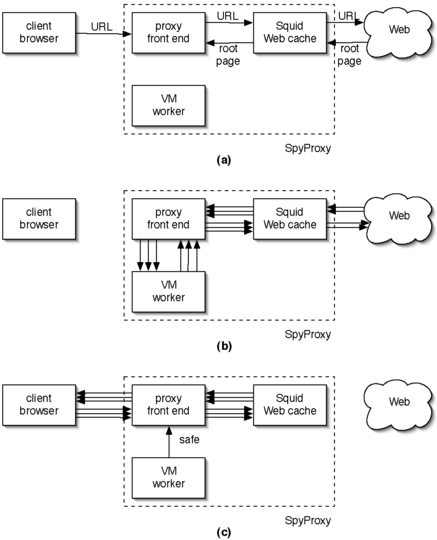
| Figure 1: SpyProxy architecture. (a) A client
browser requests a Web page; the proxy front end intercepts the
request, retrieves the root page, and statically analyzes it for
safety. (b) If the root page cannot be declared safe statically,
the front end forwards the URL to a VM worker. A browser in the
VM downloads and renders the page content. All HTTP transfers
flow through the proxy front end and a Squid cache. (c) If the
page is safe, the VM notifies the front end, and the page content
is released to the client browser from the Squid cache. Note that
if the page has been cached and was previously determined to be
safe, the front end forwards it directly to the client.
|
Figure 1 shows the architecture of a simplified
version of SpyProxy. Key components include the client browser,
SpyProxy, and remote Web servers. When the client browser
issues a new request to a Web server, the request first flows through
SpyProxy where it is checked for safety. When a user requests a Web page, the browser software generates an
HTTP request that SpyProxy must intercept. Proxies typically use one
of two methods for this: browser configuration (specifying an HTTP
proxy) or network-level forwarding that transparently redirects HTTP
requests to a proxy. Our prototype system currently relies on manual
browser configuration. The SpyProxy front end module receives clients' HTTP requests and
coordinates their processing, as shown in
Figure 1(a). First, it fetches the root page using
a cache module (we use Squid in our prototype). If the cache misses,
it fetches the data from the Web, caching it if possible and then
returning it to the front end. Second, the front end statically
analyzes the page (described below) to determine whether it is
safe. If safe, the proxy front end releases the root page content to
the client browser, and the client downloads and renders it and any
associated embedded objects. If the page cannot be declared safe statically, the front end sends
the page's URL to a virtual machine (VM) worker for dynamic analysis
(Figure 1(b)). The worker directs a browser
running in its VM to fetch the requested URL, ultimately causing
it to generate a set of HTTP requests for the root page and any
embedded objects. We configure the VM's browser to route these
requests first through the front end and then through the locally
running Squid Web cache. Routing it through the front end facilitates
optimizations that we will describe in
Section 3. Routing the request through Squid
lets us reduce interactions with the remote Web server. The browser in the VM worker retrieves and renders the full Web page,
including the root page and all embedded content. Once the full page
has been rendered, the VM worker informs the front end as to whether
it has detected suspicious activity; this is done by observing the
behavior of the page during rendering, as described below. If so, the
front end notifies the browser that the page is unsafe. If not, the
front end releases the main Web page to the client browser, which
subsequently fetches and downloads any embedded objects
(Figure 1(c)).
2.3.1 Static Analysis of Web ContentOn receiving content from the Internet, the SpyProxy front end first
performs a rudimentary form of static analysis, as previously noted.
The goal of static analysis is simple: if we can verify that a page is
safe, we can pass it directly to the client without a sophisticated
and costly VM-based check. If static analysis were our only checking
technique, our analysis tool would need to be complex and complete.
However, static analysis is just a performance optimization. Content
that can be analyzed and determined to be safe is passed directly to
the client; content that cannot is passed to a VM worker for
additional processing. Our static analyzer is conservative. If it cannot identify or process
an object, it declares it to be potentially unsafe and submits it to a
VM worker for examination. For example, our analyzer currently
handles normal and chunked content encodings, but not compressed
content. Future improvements to the analyzer could reduce the number
of pages forwarded to the VM worker and therefore increase
performance. When the analyzer examines a Web page, it tries to determine whether
the page is active or passive. Active pages include
executable content, such as ActiveX, JavaScript, and other code;
passive pages contain no such interpreted or executable code. Pages
that contain active content must be analyzed dynamically. It is possible for seemingly passive content to compromise the user's
system if the renderer has security holes. Such flaws have occurred
in the past in both the JPEG and PNG image libraries. For this
reason, we consider any non-HTML content types to be unsafe and send
them for dynamic processing. In principle, a browser's HTML processor
could have vulnerabilities in it as well; it is possible to configure
SpyProxy to disable all static checking if this is a concern. We validated the potential benefits of static checking with a small
measurement study, where we collected a 17-hour trace of Web requests
generated by the user population in our department. We saw that
54.8% of HTML pages transferred contain passive content. Thus, there
can be significant benefit in identifying these pages and avoiding our
VM-based check for them.
2.3.2 Execution-based Analysis through VM-based Page
RenderingA drive-by download attack occurs when a Web page exploits a flaw in
the victim's browser. In the worst case, an attack permits the
attacker to install and run arbitrary software on the victim's
computer. Our execution-based approach to detecting such attacks is
adapted from a technique we developed in our earlier spyware
measurement study [28], where we used virtual
machines to determine whether a Web page had malicious content. We
summarize this technique here. Our detection method relies on the assumption that malicious Web content
will attempt to break out of the security sandbox implemented by the
browser. For example, the simple act of rendering a Web page should
never cause any of the following side-effects: the creation of a new
process other than known helper applications, modifications to the
file system outside of safe folders such as the browser cache,
registry modifications, browser or OS crashes, and so on. If we can
determine that a Web page triggers any of these unacceptable
conditions, we have proof that the Web page contains malicious
content. To analyze a Web page, we use a “clean” VMware [45]
virtual machine configured with unnecessary services disabled. We
direct an unmodified browser running in the VM to fetch and render the
Web page. Because we disabled other services, any side effects we
observe must be caused by the browser rendering the Web page. We
monitor the guest OS and browser through “triggers” installed to
look for sandbox violations, including those listed above. If a
trigger fires, we declare the Web page to be unsafe. This mechanism
is described in more detail in [28]. Note that this technique is behavior-based rather than
signature-based. We do not attempt to characterize vulnerabilities;
instead, we execute or render content to look for evidence of
malicious side-effects. Accordingly, given a sufficiently
comprehensive set of trigger conditions, we can detect zero-day
attacks that exploit vulnerabilities that have not yet been
identified.
2.4 Limitations
Our approach is effective, but has a number of challenges and
limitations. First, the overhead of cloning a VM, rendering content
within it, and detecting trigger conditions is potentially high. In
Section 3 we describe several optimizations to
eliminate or mask this overhead, and we evaluate the success of these
optimizations in Section 4. Second, our trigger
monitoring system should be located outside the VM rather than inside
it, to prevent it from being tampered with or disabled by the malware
it is attempting to detect. Though we have not done so, we believe we
could modify our implementation to use techniques such as VM
introspection [18] to accomplish this. Third,
pre-executing Web content on-the-fly raises several correctness and
completeness issues, which we discuss below.
2.4.1 Non-determinism
With SpyProxy in place, Web content is rendered twice, once in the
VM's sandboxed environment and once on the client. For our technique
to work, all attacks must be observed by the VM: the client must never
observe an attack that the VM-based execution missed. This will be
true if the Web content is deterministic and follows the same
execution path in both environments. In this way, SpyProxy is ideal
for deterministic Web pages that are designed to be downloaded and
displayed to the user as information. However, highly interactive Web pages resemble general-purpose
programs whose execution paths depend on non-deterministic factors
such as randomness, time, unique system properties, or user input. An
attacker could use non-determinism to evade detection. For example, a
malicious script could flip a coin to decide whether to carry out an
attack; this simple scheme would defeat SpyProxy 50% of the time. As a more pertinent example, if a Web site relies on JavaScript to
control ad banner rotation, it is possible that the VM worker will see
a benign ad while the client will see a malicious ad. Note, however,
that much of Internet advertising today is served from ad networks
such as DoubleClick or Advertising.com. In these systems, a Web page
makes an image request to the server, and any non-determinism in
picking an ad happens on the server side. In this case, SpyProxy will
return the same ad to both the VM worker and the client. In general,
only client-side non-determinism could cause problems for SpyProxy. There are some potential solutions for handling non-determinism in
SpyProxy. Similar to ReVirt [12], we could log
non-deterministic events in the VM and replay them on the client; this
likely would require extensive browser modifications. We could
rewrite the page to make it deterministic, although a precise method
for doing this is an open problem, and is unlikely to generalize
across content types. The results of VM-based rendering can be
shipped directly to the client using a remote display protocol,
avoiding client-side rendering altogether, but this would break the
integration between the user's browser and the rest of their computing
environment. None of these approaches seem simple or satisfactory; as a result, we
consider malicious non-determinism to be a fundamental limitation to
our approach. In our prototype, we did not attempt to solve the
non-determinism problem, but rather we evaluated its practical impact
on SpyProxy's effectiveness. Our results in Section 4
demonstrate that our system detected all malicious Web pages that it
examined, despite the fact that the majority of them contained
non-determinism. We recognize that in the future, however, an
adversary could introduce non-determinism in an attempt to evade
detection by SpyProxy.
2.4.2 TerminationOur technique requires that the Web page rendering process terminates
so that we can decide whether to block content or forward it to the
user. SpyProxy uses browser interfaces to determine when a Web page
has been fully rendered. Unfortunately, for some scripts termination
depends on timer mechanisms or user input, and in general, determining
when or whether a program will terminate is not possible. To prevent “timebomb-based” attacks, we speed up the virtual time in
the VM [28]. If the rendering times out, SpyProxy
pessimistically assumes the page has caused the browser to hang and
considers it unsafe. Post-rendering events, such as those that fire
because of user input, are not currently handled by SpyProxy, but
could be supported with additional implementation. For example, we
could keep the VM worker active after rendering and intercept the
events triggered because of user input to forward them to the VM for
pre-checking. The interposition could be accomplished by inserting
run-time checks similar to BrowserShield [33].
2.4.3 Differences Between the Proxy and ClientIn theory, the execution environment in the VM and on the client
should be identical, so that Web page rendering follows the same
execution path and produces the same side-effects in both executions.
Differing environments might lead to false positives or false
negatives. In practice, malware usually targets a broad audience and small
differences between the two environments are not likely to matter.
For our system, it is sufficient that harmful side-effects produced at
the client are a subset of harmful side-effects produced in the VM.
This implies that the VM system can be partially patched, which makes
it applicable for all clients with a higher patch level. Currently,
SpyProxy uses unpatched Windows XP VMs with an unpatched IE browser.
As a result, SpyProxy is conservative and will block a threat even if
the client is patched to defend against it. There is a possibility that a patch could contain a bug, causing a
patched client to be vulnerable to an attack to which the unpatched
SpyProxy is immune [24]. We assume this is a rare
occurrence, and do not attempt to defend against it.
2.5 Client-side vs. Network DeploymentAs we hinted before, SpyProxy has a flexible implementation: it can be
deployed in the network infrastructure, or it can serve as a
client-side proxy. There are many tradeoffs involved in picking one
or the other. For example, a network deployment lets clients benefit
from the workloads of other clients through caching of both data and
analysis results. On the other hand, a client-side approach would
remove the bottleneck of a centralized service and the latency of an
extra network hop. However, clients would be responsible for running
virtualization software that is necessary to support SpyProxy's VM
workers. Many challenges, such as latency optimizations or
non-determinism issues, apply in both scenarios. While designing our prototype and carrying out our evaluation, we
decided to focus on the network-based SpyProxy. In terms of
effectiveness, the two approaches are identical, but obtaining good
performance with a network deployment presents more challenges.
3 Performance Optimizations
The simple proxy architecture described in
section 2 will detect and block malicious Web
content effectively, but it will perform poorly. For a given Web page
request, the client browser will not receive or render any content
until the proxy has downloaded the full page from the remote Web
server, rendered it in a VM worker, and satisfied itself that no
triggers have fired. Accordingly, many of the optimizations that Web
browsers perform to minimize perceived latency, such as pipelining the
transfer of embedded objects and the rendering of elements within the
main Web page, cannot occur. To mitigate the cost of VM-based checking in our proxy, we implemented
a set of performance optimizations that either enable the browser to
perform its normal optimizations or eliminate proxy overhead
altogether.
3.1 Caching the Result of Page ChecksWeb page popularity is known to follow a Zipf
distribution [6]. Thus, a significant fraction of
requests generated by a user population are repeated requests for the
same Web pages. Web proxy caches take advantage of this fact to
reduce Web traffic and improve response
times [1, 13, 15, 21, 52, 53]. Web caching
studies generally report hit rates as high as 50%. Given this, our first optimization is caching the result of our
security check so that repeated visits to the same page incur the
overhead of our VM-based approach only once. In principle, the hit
rate in our security check cache should be similar to that of Web
caches. This basic idea faces complications. The principle of complete
mediation warns against caching security checks, since changes to the
underlying security policy or resources could lead to caching an
incorrect outcome [34]. In our case, if any component in
a Web page is dynamically generated, then different clients may be
exposed to different content. However, in our architecture, our use
of the Squid proxy ensures that no confusion can occur: we cache the
result of a security check only for objects that Squid also caches,
and we invalidate pages from the security cache if any of the page's
objects is invalid in the Squid cache. Thus, we generate a hit in the
security cache only if all of the Web page content will be served out
of the Squid proxy cache. Caching checks for non-deterministic pages
is dangerous, and we take the simple step of disabling the security
cache for such pages.
3.2 Prefetching Content to the ClientIn the unoptimized system shown in Figure 1, the
Web client will not receive any content until the entire Web page has
been downloaded, rendered, and checked by SpyProxy. As a result, the
network between the client and the proxy remains idle when the page is
being checked. If the client has a low-bandwidth network connection,
or if the Web page contains large objects, this idle time represents a
wasted opportunity to begin the long process of downloading content to
the client. To rectify this, SpyProxy contains additional components and protocols
that overlap several of the steps shown in
Figure 1. In particular, a new client-side
component acts as a SpyProxy agent. The client-side agent both
prefetches content from SpyProxy and releases it to the client
browser once SpyProxy informs it that the Web page is safe. This
improves performance by transmitting content to the client in parallel
with checking the Web page in SpyProxy. Because we do not give any
Web page content to the browser before the full page has been checked,
this optimization does not erode security. In our prototype, we implemented the client-side agent as an IE
plugin. The plugin communicates with the SpyProxy front end, spooling
Web page content and storing it until SpyProxy grants it authorization
to release the content to the browser.
3.3 The Staged Release of ContentAlthough prefetching allows content to be spooled to the client while
SpyProxy is performing its security check, the user's browser cannot
begin rendering any of that content until the full Web page has been
rendered and checked in the VM worker. This degrades
responsiveness, since the client browser cannot take advantage of its
performance optimizations that render content well before the full
page has arrived. We therefore implemented a “staged release” optimization. The goal
of staged release is to present content considered safe for rendering
to the client browser in pieces; as soon as the proxy believes that a
slice of content (e.g., an object or portion of an HTML page) is safe,
it simultaneously releases and begins transmitting that content to the
client. Figure 2 depicts the process of staged release. A page
consists of a root page (typically containing HTML) and a set of
embedded objects referred to from within the root page. As a Web
browser downloads and renders more and more of the root page, it
learns about embedded objects and begins downloading and rendering
them.
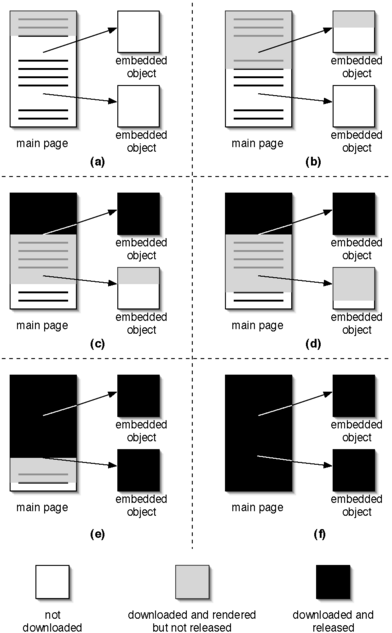
| Figure 2: Staged release optimization.
The progression of events in the VM worker's browser
shows how staged release operates on a Web page with two
embedded objects. As embedded objects become fully downloaded and
rendered by the VM worker's browser, more of the Web page is
released to the client-side browser.
|
Without staged release, the proxy releases no content until the full
Web page and its embedded objects have been rendered in the VM. With
staged release, once the VM has rendered an embedded object, it
releases that object and all of the root page content that precedes its reference. If the client browser evaluates the root
page in the same order as the VM browser, this is safe to do; our
results in Section 4 confirm this optimization is safe in
practice. Thus, a pipeline is established in which content is
transmitted and released incrementally to the client browser. In Figures 2(a) and 2(b), only part of
the main Web page has been downloaded and rendered by the VM browser.
In Figure 2(c), all of the first embedded object has
been rendered by the VM, which causes that object and some of the main
Web page content (shown in black) to be released and transmitted to
the client browser. More of the main Web page and the second embedded
object is downloaded and rendered in Figure 2(d), until
finally, in Figures 2(e) and 2(f), the
full Web page is released. Many Web pages contain dozens of embedded images. For example, CNN's
Web page contains over 32 embedded objects. Faced with such a Web
page, our staged release optimization quickly starts feeding the
client browser more and more of the root page and associated embedded
objects. As a result, the user does not observe expensive Web
access delay. Note that staged release is independent from prefetching. With
prefetching, content is pushed to the client-side agent before
SpyProxy releases it to the client browser; however, no
content is released until the full page is checked. With staged
release, content is released incrementally, but released content is
not prefetched. Staged release can be combined with prefetching, but
since it does not require a client-side agent to function,
it may be advantageous to implement staged release without
prefetching. We evaluate each of these optimizations independently
and in combination in Section 4.
3.4 Additional optimizationsSpyProxy contains a few additional optimizations. First, the VM worker
is configured to have a browser process already running inside, ready
to accept a URL to retrieve. This avoids any start-up time associated
with booting the guest OS or launching the browser. Second, the
virtual disk backing the VM worker is stored in a RAM-disk file system
in the host OS, eliminating the disk traffic associated with storing
cookies or files in the VM browser. Finally, instead of cloning a new
VM worker for every client request, we re-use VM workers across
requests, garbage collecting them only after a trigger fires or a
configurable number of requests has occurred. Currently, we garbage
collect a worker after 50 requests.
4 Evaluation
This section evaluates the effectiveness and performance of our
SpyProxy architecture and prototype. The prototype includes the
performance optimizations we described previously. Our results
address three key questions: how effective is our system at detecting
and blocking malicious Web content, how well do our performance
optimizations mask latency from the user, and how well does our system
perform given a realistic workload?
4.1 Effectiveness at Blocking Malicious Code
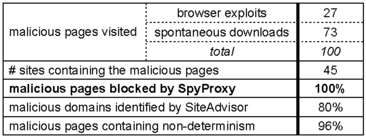
| Table 1: Effectiveness of SpyProxy.
The effectiveness of SpyProxy at detecting and blocking
malicious Web content. SpyProxy was successful at detecting and
blocking 100% of the malicious Web pages we visited, in spite of
the fact that most of them contained non-determinism. In
comparison, the SiteAdvisor service incorrectly classified 20% of
the malicious Web domains as benign.
|
We first consider the ability of SpyProxy to successfully block
malicious content. To quantify this, we manually gathered a list of
100 malicious Web pages on 45 distinct sites. Each of these pages
performs an attack of some kind. We found these pages using a
combination of techniques, including: (1) searching Google for popular
Web categories such as music or games, (2) mining public blacklists of
known attack sites, and (3) examining public warning services such as
SiteAdvisor. Some of the Web pages we found exploit browser vulnerabilities to
install spyware. Others try to “push” malicious software at clients
spontaneously, requiring user consent to install it; we have
configured SpyProxy to automatically accept such prompts to evaluate
its effectiveness at blocking these threats. The pages include a
diversity of attack methods, such as the WMF exploit, ActiveX
controls, applet-based attacks, JavaScript, and pop-up windows. A
successful attack inundates the victim with adware, dialer, and Trojan
downloader software. Table 1 quantifies the effectiveness of our
system. SpyProxy detected and blocked 100% of the attack pages,
despite the diversity of attack methods to which it was exposed.
Further, most of these attack pages contained some form of
non-deterministic content; in practice, none of the attacks we found
attempted to evade detection by “hiding” inside non-deterministic
code. The table also shows the advantage of our on-the-fly approach
compared to a system like SiteAdvisor, which provides static
recommendations based on historical evidence. SiteAdvisor
misclassified 20% of the malicious sites as benign. While we cannot
explain why SiteAdvisor failed on these sites, we suspect it is due to
a combination of incomplete Web coverage (i.e., not having examined
some pages) and stale information (i.e., a page that was benign when
examined has since become malicious). SpyProxy's on-the-fly approach
examines Web page content as it flows towards the user, resulting in a
more complete and effective defense. For an interesting example of how SpyProxy works in practice, consider
www.crackz.ws, one of our 100 malicious pages. This page
contains a specially crafted image that exploits a vulnerability in
the Windows graphics rendering engine. The exploit runs code that
silently downloads and installs a variety of malware, including
several Trojan downloaders. Many signature-based anti-malware tools
would not prevent this attack from succeeding; they would instead
attempt to remove the malware after the exploit installs it. In contrast, when SpyProxy renders a page from www.crackz.ws in
a VM, it detects the exploit when the page starts performing
unacceptable activity. In this case, as the image is rendered in the
browser, SpyProxy detects an unauthorized creation of ten helper
processes. SpyProxy subsequently blocks the page before the client
renders it. Note that SpyProxy does not need to know any details of
the exploit to stop it. Equally important, in spite of the fact that
the exploit attacks a non-browser flaw that is buried deep in the
software stack, SpyProxy's behavior-based detection allowed it to
discover and prevent the attack.
4.2 Performance of the Unoptimized SystemThis section measures the performance of the basic unoptimized
SpyProxy architecture we described in Section 2.3.
These measurements highlight the limitations of the basic approach;
namely, unoptimized SpyProxy interferes with the normal browser
rendering pipeline by delaying transmission until an entire page is
rendered and checked. They also suggest opportunities for
optimization and provide a baseline for evaluating the effectiveness
of those optimizations. We ran a series of controlled measurements, testing SpyProxy under
twelve configurations that varied across the following three
dimensions: -
Proxy configuration. We compared a regular browser
configured to communicate directly with Web servers with a
browser that routes its requests through the SpyProxy checker.
- Client-side network. We compared a browser running
behind an emulated broadband connection with a browser running on
the same gigabit Ethernet LAN as SpyProxy. We used the
client-side NetLimiter tool and capped the upload and download
client bandwidth at 1.5 Mb/s to emulate the broadband connection.
- Web page requested. We measured three different Web
pages: the Google home page, the front page of the New York
Times, and the “MSN shopping insider” blog, which contains
several large, embedded images. The Google page is small: just
3,166 bytes of HTML and a single 8,558 byte embedded GIF. The
New York Times front page is larger and more complex: 92KB
of HTML, 74 embedded images, 4 stylesheets, 3 XML objects, 1 flash
animation, and 10 embedded JavaScript objects. This represents
844KB of data. The MSN blog consists of a 79KB root HTML page, 18
embedded images (the largest of which is 176KB), 2 stylesheets,
and 1 embedded JavaScript object, for a total of 1.4MB of data.
For each of the twelve configurations, we created a timeline showing
the latency of each step from the client's Web page request to the
final page rendering in the client. We broke the end-to-end
latency into several components, including WAN transfer delays, the
overhead of rendering content in the VM worker before releasing it to
the client, and internal communication overhead in the SpyProxy
system itself. We cleared all caches in the system to ensure that
content was retrieved from the original Web servers in all cases.
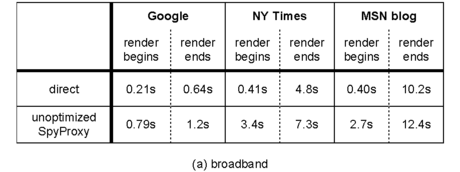
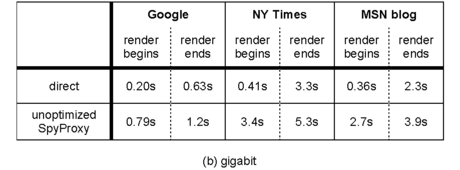
| Table 2: Performance of the unoptimized SpyProxy.
These tables compare the latency of an unprotected browser that
downloads content directly from Web servers to that of a protected
browser downloading through the SpyProxy service. We show the
latency until the page begins to render on the client and the
latency until the page finishes rendering. The data are shown for
three Web pages as well the client on (a) an emulated broadband
access link, and (b) the same LAN as SpyProxy.
|
For each configuration, Table 2 shows the time
until content first begins to render on the user's screen and the
time until the Web page finishes rendering. In all cases, the
unoptimized SpyProxy implementation added less than three seconds to
the total page download time. However, the time until rendering
began was much higher on the unoptimized system, growing in some cases
by a factor of ten. This confirms that our system can perform well,
but, without optimizations, it interferes with the browser's ability
to reduce perceived latency by pipelining the transfer and rendering
of content.
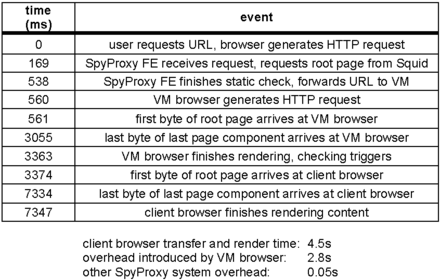
| Table 3: Detailed breakdown of the unoptimized
SpyProxy. Events occurring when fetching the New York Times
page over broadband through SpyProxy. Most SpyProxy overhead is
due to serializing the VM browser download and trigger checks
before transferring or releasing content to the client browser.
|
Table 3 provides a more detailed timeline of
events when fetching the New York Times page from a broadband
client using the unoptimized SpyProxy. Downloading and rendering the
page in the VM browser introduced 2.8 seconds of overhead. Since
no data flows to the client browser until SpyProxy finishes rendering
and checking content, this VM rendering latency is responsible for
delay experienced by the user.
4.3 Performance OptimizationsTo reduce the overhead introduced by the unoptimized SpyProxy
system, we previously described three optimization techniques: prefetching
content to a client-side agent, the staged release of content to the
client browser, and caching the results of security checks. We now
present the results of a set of microbenchmarks that evaluate the
impact of each optimization.
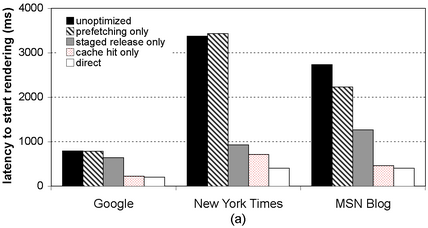
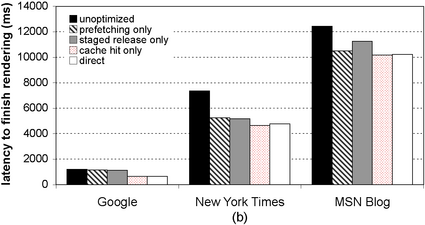
| Figure 3: Performance of optimizations (broadband).
The latency until the client browser (a) begins rendering the
page, and (b) finishes rendering the page. Each graph shows the
latency for three different pages for five configurations.
|
Figure 3 summarizes the benchmark results.
Both figures show the latency to download three different pages to a
client on the emulated broadband connection. For each page, we show
latency for five cases: (1) the unoptimized SpyProxy, (2) SpyProxy
with only prefetching enabled, (3) SpyProxy with only staged release
enabled, (4) SpyProxy with a hit in the enabled security cache, and
(5) the base case of a client fetching content directly from Web
servers. Figure 3(a) shows the latency before
page rendering begins in the client browser, while
Figure 3(b) shows the latency until page
rendering ends. In combination, the optimizations serve to reduce the latency before
the start of rendering in the client. With all of the the
optimizations in place, the page load “feels” nearly as responsive
through SpyProxy as it does without SpyProxy. In either case, the
page begins rendering about a second after the request is generated.
The optimizations did somewhat improve the total rendering latency
relative to the unoptimized implementation
(Figure 3(b)), but this was not nearly as
dramatic. Page completion time is dominated by transfer time over the
broadband network, and our optimizations do nothing to reduce this.
4.3.1 Prefetching
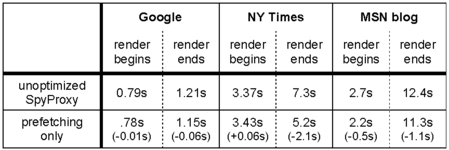
| Table 4: Prefetching (broadband).
Latency improvements gained by the prefetching optimization in the
broadband environment. Prefetching alone did not yield significant
benefits.
|
Prefetching by itself does not yield significant benefits. As shown
in Table 4, it did not reduce rendering
start-time latency. With prefetching alone, the client browser
effectively stalls while the VM browser downloads and renders the page
fully in the proxy. That is, SpyProxy does not release content to the
client's browser until the VM-based check ends. However, we did observe some improvement in finish-time measurements.
For example, the time to fully render the New York Times page
dropped by 2.1 seconds, from 7.3 seconds in the unoptimized SpyProxy
to 5.2 seconds with prefetching enabled. Prefetching successfully
overlaps some transmission of content to the client-side agent with
SpyProxy's security check, slightly lowering overall page load time.
4.3.2 Staged Release

| Table 5: Staged release (broadband). Latency
improvements from staged release in the broadband environment.
Staged release significantly improved the latency until rendering
starts. It yielded improvements similar to prefetching
in the latency until full page rendering ends.
|
Staged release very successfully reduced initial latency before
rendering started; this time period has the largest impact on perceived
responsiveness. As shown in Table 5, staged
release reduced this latency by several seconds for both the New
York Times and MSN blog pages. In fact, from the perspective of a
user, the New York Times page began rendering nearly four
times more quickly with staged release enabled. For all three pages,
initial rendering latency was near the one-second mark, implying good
responsiveness. The staged release optimization also reduced the latency of rendering
the full Web page to nearly the same point as prefetching. Even
though content does not start flowing to the client until it is
released, this optimization releases some content quickly, causing an
overlap of transmission with checking that is similar to prefetching. Staged release outperforms prefetching in the case that
matters—initial time to rendering. It also has the advantage of not
requiring a client-side agent. Once SpyProxy decides to release
content, it can simply begin uploading it directly to the client
browser. Prefetching requires the installation of a client-side
software component, and it provides benefits above staged release only
in a narrow set of circumstances (namely, pages that contain very
large embedded objects).
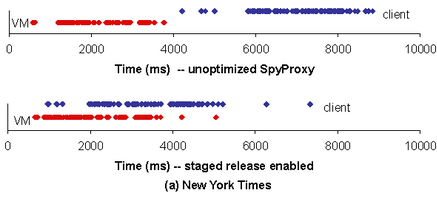
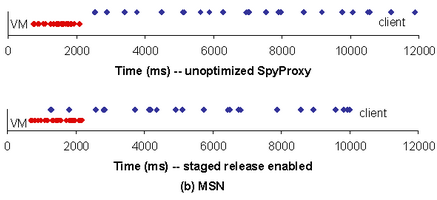
| Figure 4: Timeline of events with staged release
(broadband). The sequence of object rendering completion
events that occur over time for (a) the New York Times, and (b)
MSN blog pages. The top figures show the sequence of events for
the unoptimized SpyProxy, while the bottom figures show what
happens with staged release. In each figure, the top series of
dots represents completions in the client browser and the bottom
series in SpyProxy's VM browser. Staged release is effective at
the early release of objects to the browser.
|
To better visualize the impact of staged release,
Figure 4 depicts the sequence of Web object
completion events that occur during the download and rendering of a
page.
Figure 4(a) shows completion events for the New York Times page. The unoptimized SpyProxy (top) does not
transmit or release events to the client browser until the full page
has rendered in the VM. With staged release
(4(a) bottom), as objects are rendered and
checked by the SpyProxy VM, they are released and transmitted to the
client browser and then rendered. Accordingly, the sequence of
completion events is pipelined between the two browsers. This leads
to much more responsive rendering and an overall lower page load time. Figure 4(b) shows a similar set of events for
the MSN blog page. Since this page consists of few large embedded
images, the dominant cost in both the unoptimized and
staged-release-enabled SpyProxy implementations is the time to
transmit the images to the client over broadband. Accordingly, though
staged release permits the client browser to begin rendering more
quickly, most objects queue up for transmission over the broadband link
after being released by SpyProxy.
When a client retrieves a Web page using the optimized SpyProxy, both
the outcome of the security check and the page's content are cached in
the proxy. When a subsequent request arrives for the same page, if
any of its components are cached and still valid, our system avoids
communicating with the origin Web server. In addition, if all components
of the page are cached and still valid, the system uses the previous
security check results instead of incurring the cost of a VM-based
evaluation.
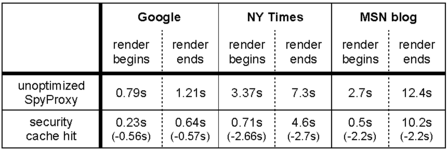
| Table 6: Security cache hit (broadband). This table shows
the latency improvements gained when the security cache optimization
is enabled and the Web page hits in the cache.
|
In Table 6, we show the latency improvement of
hitting in the security cache compared with the unoptimized SpyProxy.
As with the other optimizations, the primary benefit of the security
cache is to improve the latency until the page begins rendering.
Though the full page load time improves slightly, the transfer time
over the broadband connection still dominates. However, on a security
cache hit, the caching optimization is extremely effective, since it
eliminates the need to evaluate content in a VM.
4.4 Performance on a Realistic Workload
Previous sections examined the individual impact of each of our
optimizations. In the end, however, the question remains: how does
SpyProxy perform for a “typical” user Web-browsing workload? A more
realistic workload will cause the performance optimizations
— caching, static analysis, and staged release — to be exercised
together in response to a stream of requests. To study the behavior of SpyProxy when confronted with a realistic request
stream, we measured the response latencies of 1,909 Web page requests
issued by our broadband Web client. These requests were
generated with a Zipf popularity distribution drawn from a list of
703 different safe URLs from 124 different sites. We chose the URLs
by selecting a range of popular and unpopular sites ranked by the
Alexa ranking service. By selecting real sites, we exercised our
system with the different varieties and complexities of Web page
content to which users are typically exposed. By generating our
workload with a Zipf popularity distribution, we gave our caching
optimization the opportunity to work in a realistic scenario. None of
the sites we visited contained attacks; our goal was simply to
evaluate the performance impact of SpyProxy on browsing. Figure 5(a) presents a cumulative distribution
function for the time to start page rendering in the client browser.
This is the delay the user sees before the browser
responds to a request. Figure 5(b) shows the CDF
for full-page-load latencies. Each figure depicts distributions for
three cases: (1) directly connecting to the Web site without
SpyProxy, (2) using the optimized SpyProxy implementation, and (3) using
SpyProxy with optimizations disabled. We flushed all caches before
gathering the data for each distribution.
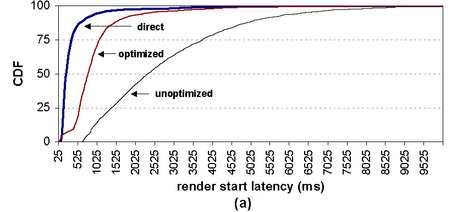
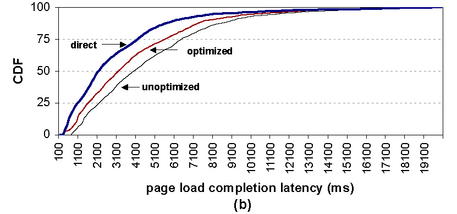
| Figure 5: Overall performance (broadband). These
graphs show the distributions of (a) render start latencies and
(b) full page load latencies for a workload consisting of 1,909
requests issued to 703 pages from 102 Web sites. Each graph
compares the response time for a direct client, the unoptimized
system, and the fully optimized system. The artifact visible
at low latencies on the optimized line in (a) corresponds
to hits in our security cache.
|
Our results demonstrate that the optimized SpyProxy system delivers
content to browsers very quickly. The median time until rendering
began was 0.8 seconds in the optimized system compared to 2.4 seconds
in the unoptimized system. There is still room to improve; the median
start time for the direct connection was 0.2 seconds. However, the
optimized system feels acceptably fast to a user. In contrast, the
unoptimized system seems noticeably sluggish compared to the optimized
system and direct connections. A typical request flowing through the optimized system involves
several potential sources of overhead, including interacting with the
Squid proxy cache and pre-executing content in a virtual machine. In
spite of this, the optimized SpyProxy effectively masks latency,
resulting in an interactive, responsive system. In addition, our
system generated very few false positives: only 4 of the 1,909 Web
page requests resulted in an alarm being raised. Even though the
offending pages were benign, they did in fact attempt to install
software on the user's computer, albeit by requesting permission from
the user first. For example, one of the pages prompted the user to
install a browser plug-in for the QuickTime media player. We chose
not to deal with such opt-in installers, as SpyProxy is primarily
intended for zero-day attacks that never ask for permission before
installing malware.
However, we do reduce the number of false positives by including the
most common browser plug-ins, such as Flash, in the base VM image.
4.5 ScalabilitySpyProxy is designed to service many concurrent users in an
organizational setting. Our implementation runs on a cluster of
workstations, achieving incremental scalability by executing VM
workers on additional nodes. We now provide some back-of-the-envelope
estimations of SpyProxy's scalability. We have not performed an
explicit scaling benchmark, but our calculations do provide an
approximate indication of how many CPUs would be necessary to support
user population of a given size. Our estimate is based on the assumption that the CPU is likely to be
the bottleneck of a deployed system; for this to be true, the system
must be configured with an adequate amount of memory and network
bandwidth to support the required concurrent virtual machines and Web
traffic. While performing the evaluation in
section 4.4, we measured the amount of CPU time
required to process a Web page in SpyProxy. On a 2.8GHz Pentium 4
machine with 4GB of RAM and a single 80GB 7200 RPM disk, we found the
average CPU time consumed per page was 0.35 seconds. There is little published data on the number of Web pages users view
per day. In a study of Internet content-delivery
systems [38], users requested 930 HTTP objects per day on
average, and another study found that an average Web page contains
about 15 objects [27]. Combining these, we
conservatively estimate that a typical user browses through 100 pages
per day. Assuming this browsing activity is uniformly distributed
over an 8-hour workday, one CPU can process 82286 Web pages per day,
implying a single-CPU SpyProxy could support approximately 822 users.
A single quad-core machine should be able to handle the load from an
organization containing a few thousand people.
4.6 SummaryThis section evaluated the effectiveness and performance of our
SpyProxy prototype. Our measurements demonstrated that SpyProxy
effectively detects malicious content. In our experiments, SpyProxy
correctly detected and blocked every threat, including several that
SiteAdvisor failed to identify. Our experiments with fully optimized
SpyProxy show that a proxy-based spyware checker can be implemented
with only minimal performance impact on the user. On average, the use
of SpyProxy added only 600 milliseconds to the user-visible latency before
rendering starts. In our experience using the system, this
small additional overhead does not noticeably degrade the system's
responsiveness.
5 Related Work
We now discuss related research on spyware detection and prevention,
intrusion detection and firewall systems, and network proxies.
5.1 Spyware and Malware DetectionIn previous work, we used passive network monitoring to measure adware
propagation on the University of Washington
campus [37]. In a follow-on study, we used Web
crawling to find and analyze executable programs and Web pages that
lead to spyware infections [28]; the trigger-based
VM analysis technique in that work forms the foundation for SpyProxy's
detection mechanism. Strider HoneyMonkey [49] and the commercial
SiteAdvisor service [41] both use a VM-based technique
similar to ours to characterize malicious Web sites and pages. Our
work differs in two main ways: we show that our VM-based technique can
be used to build a transparent defense system rather than a
measurement tool, and we examine optimizations that enable our system
to perform efficiently and in real time. Our system detects malicious Web content by executing it and looking
for evidence of malicious side-effects. Other systems have attempted
to detect malware by examining side-effects, including
Gatekeeper [51], which monitors Windows extensibility
hooks for evidence of spyware installation. Another recent detector
identifies spyware by monitoring API calls invoked when sensitive
information is stolen and transmitted [20].
However, these systems only look for malware that is already
installed. In contrast, SpyProxy uses behavioral analysis to prevent malware installation. Other works have looked at addressing limitations of signature-based
detection. Semantics-aware malware detection [8]
uses an instruction-level analysis of programs to match their behavior
against signature templates. This technique improves malware
detection, but not prevention. Several projects explore automatic
generation of signatures for detection of unknown malware
variants [7, 29, 40, 46, 48].
These typically need attack traffic and time to generate signatures,
leaving some clients vulnerable when a new threat first appears. Some commercial client-side security tools have begun to incorporate
behavioral techniques, and two recent products, Prevx1 [32]
and Primary Response SafeConnect [35], use purely behavioral
detection. However, these tools must run on systems packed with
client-installed programs, which limits their behavioral analysis. In
contrast, SpyProxy pre-executes content in a clean sandbox, where it
can apply a much stricter set of behavioral rules. Other approaches prevent Web-based malware infestations by protecting
the user's system from the Web browser using VM
isolation [10], OS-level sandboxing [16, 36], or
logging/rollback [17]. Fundamentally, this
containment approach is orthogonal to our prevention
approach. Although these tools provide strong isolation, they have
different challenges, such as data sharing and client-side performance
overhead. Remote playgrounds move some of the browser functionality (namely,
execution of untrusted Java applets) away from the client desktop and
onto dedicated machines [26]; the client browser becomes an
I/O terminal to the actual browser running elsewhere. Our
architecture is different — SpyProxy pre-executes Web pages
using an unmodified browser and handles any form of active code,
allowing it to capture a wider range of attacks. Nevertheless,
SpyProxy could benefit from this technique in the future, for example
by forwarding user input to the VM worker in AJAX sites. Several projects tackle the detection and prevention of other
classes of malware, including worms, viruses, and
rootkits [19, 39, 50]. SpyProxy
complements these defenses with protection against Web-borne attacks,
resulting in better overall desktop security.
5.2 Intrusion Detection and FirewallsIntrusion detection systems (e.g., Bro [31] and
snort [42]) protect networks from attack by searching through
incoming packets for known attack signatures. These systems are
typically passive, monitoring traffic as it flows into a network and
alerting a system administrator when an attack is suspected. More
sophisticated intrusion detection systems attempt to identify
suspicious traffic using anomaly
detection [3, 4, 22, 23]. A
related approach uses protocol-level analysis to look for attacks that
exploit specific vulnerabilities, such as Shield [47]. The
same idea has been applied at the HTML level in client-side
firewalls and proxies [25, 30, 33]. These systems typically look for attack signatures for
well-established protocols and services. As a result, they cannot
detect new or otherwise undiscovered attacks. Since they are
traditionally run in a passive manner, attacks are detected but not
prevented. Our system executes potentially malicious content in a
sandboxed environment, using observed side-effects rather than
signatures to detect attacks and protect clients. Shadow honeypots combine network intrusion detection systems and
honeypots [2]. They route risky network traffic
to a heavily instrumented version of a vulnerable application, which
detects certain types of attacks at run-time. In contrast, SpyProxy
does not need to instrument the Web browser that it guards, and its
run-time checks are more general and easier to define.
5.3 ProxiesProxies have been used to introduce new services between Web clients
and servers. For example, they have been used to provide scalable
distillation services for mobile clients [14], Web
caching [1, 13, 15, 21, 52, 53], and
gateway services for onion-routing anonymizers [11]. SpyProxy
builds on these advantages, combining active content checking with
standard proxy caching. SpyBye [30] is a Web proxy that uses
a combination of blacklisting, whitelisting, ClamAV-based virus
scanning, and heuristics to identify potentially malicious Web
content. In contrast, SpyProxy uses execution-based analysis to
identify malicious content.
6 Conclusions
This paper described the design, implementation, and evaluation of
SpyProxy, an execution-based malware detection system that protects
clients from malicious Web pages, such as drive-by-download attacks.
SpyProxy executes active Web content in a safe virtual machine before it reaches the browser. Because SpyProxy relies on the
behavior of active content, it can block zero-day attacks and
previously unseen threats. For performance, SpyProxy benefits from a
set of optimizations, including the staged release of content and
caching the results of security checks. Our evaluation of SpyProxy demonstrates that it meets its
goals of safety, responsiveness, and transparency: -
SpyProxy successfully detected and blocked all of the threats it
faced, including threats not identified by other detectors.
- The SpyProxy prototype adds only 600 milliseconds of latency to
the start of page rendering—an amount that is negligible in the
context of browsing over a broadband connection.
- Our prototype integrates easily into the network and its
existence is transparent to users.
Execution-based analysis does have limitations. We described several
of these, including issues related to non-determinism, termination,
and differences in the execution environment between the client and
the proxy. There are many existing malware detection tools, and although none of
them are perfect, together they contribute to a “defense in depth”
security strategy. Our goal is neither to build a perfect tool nor to
replace existing tools, but to add a new weapon to the Internet
security arsenal. Overall, our prototype and experiments demonstrate
the feasibility and value of on-the-fly, execution-based defenses
against malicious Web-page content.
References-
[1]
-
Virgílio Almeida, Azer Bestavros, Mark Crovella, and Adriana de Oliveira.
Characterizing reference locality in the WWW.
In Proceedings of the IEEE Conference on Parallel and
Distributed Information Systems (PDIS '96), Miami Beach, FL, December
1996.
- [2]
-
Kostas G. Anagnostakis, Stelios Sidiroglou, Periklis Akritidis, Konstantinos
Xinidis, Evangelos Markatos, and Angelos D. Keromytis.
Detecting targeted attacks using shadow honeypots.
In Proceedings of the 14th USENIX Security Symposium, August
2005.
- [3]
-
Kevin Borders and Atul Prakash.
Web tap: Detecting covert Web traffic.
In Proceedings of the 11th ACM Conference on Computer and
Communications Security (CCS '04), New York, NY, October 2004.
- [4]
-
Kevin Borders, Xin Zhao, and Atul Prakash.
Siren: Catching evasive malware (short paper).
In Proceedings of the 2006 IEEE Symposium on Security and
Privacy, Washington, DC, May 2006.
- [5]
-
Tanya Bragin.
Measurement study of the Web through a spam lens.
Technical Report TR-2007-02-01, University of Washington, Computer
Science and Engineering, February 2007.
- [6]
-
Lee Breslau, Pei Cao, Li Fan, Graham Phillips, and Scott Shenker.
Web caching and Zipf-like distributions: Evidence and
implications.
In Proceedings of 18th Annual IEEE Conference on Computer
Communications (IEEE INFOCOM '99), March 1999.
- [7]
-
David Brumley, James Newsome, Dawn Song, Hao Wang, and Somesh Jha.
Towards automatic generation of vulnerability-based signatures.
In Proceedings of the 2006 IEEE Symposium on Security and
Privacy, Washington, DC, May 2006.
- [8]
-
Mihai Christodorescu, Somesh Jha, Sanjit A. Seshia, Dawn Song, and Randal E.
Bryant.
Semantics-aware malware detection.
In Proceedings of the 2005 IEEE Symposium on Security and
Privacy, Oakland, CA, May 2005.
- [9]
-
Andrew Conry-Murray.
Product focus: Behavior-blocking stops unknown malicious code.
https://mirage.cs.ucr.edu/mobilecode/resources_files/behavior.pdf, June
2002.
- [10]
-
Richard Cox, Steven Gribble, Henry Levy, and Jacob Hansen.
A safety-oriented platform for Web applications.
In Proceedings of the 2006 IEEE Symposium on Security and
Privacy, Washington, DC, May 2006.
- [11]
-
Roger Dingledine, Nick Mathewson, and Paul Syverson.
Tor: The second-generation onion router.
In Proceedings of the 13th USENIX Security Symposium, San
Diego, CA, August 2004.
- [12]
-
George W. Dunlap, Samuel T. King, Sukru Cinar, Murtaza Basrai, and Peter M.
Chen.
ReVirt: Enabling intrusion analysis through virtual-machine
logging and replay.
In Proceedings of the 5th USENIX Symposium on Operating
Systems Design and Implementation (OSDI '02), Boston, MA, December 2002.
- [13]
-
Brian Duska, David Marwood, and Michael J. Feeley.
The measured access characteristics of World Wide Web client
proxy caches.
In Proceedings of the 1st USENIX Symposium on Internet
Technologies and Systems (USITS '97), Monterey, CA, December 1997.
- [14]
-
Armando Fox, Steven Gribble, Yatin Chawathe, Eric A. Brewer, and Paul Gauthier.
Cluster-based scalable network services.
In Proceedings of the 16th ACM Symposium on Operating Systems
Principles (SOSP '97), St.-Malo, France, October 1997.
- [15]
-
Steven Glassman.
A caching relay for the World Wide Web.
Computer Networks and ISDN Systems, 27(2):165–173, 1994.
- [16]
-
Green Border Technologies.
GreenBorder desktop DMZ solutions.
https://www.greenborder.com, November 2005.
- [17]
-
Francis Hsu, Hao Chen, Thomas Ristenpart, Jason Li, and Zhendong Su.
Back to the future: A framework for automatic malware removal and
system repair.
In Proceedings of the 22nd Annual Computer Security Applications
Conference (ACSAC '06), Washington, DC, December 2006.
- [18]
-
Ashlesha Joshi, Samuel T. King, George W. Dunlap, and Peter M. Chen.
Detecting past and present intrusions through vulnerability-specific
predicates.
In Proceedings of the 20th ACM Symposium on Operating Systems
Principles (SOSP '05), Brighton, United Kingdom, October 2005.
- [19]
-
Darrell Kienzle and Matthew Elder.
Recent worms: A survey and trends.
In Proceedings of the 2003 ACM Workshop on Rapid Malcode
(WORM '03), Washington, DC, October 2003.
- [20]
-
Engin Kirda, Christopher Kruegel, Greg Banks, Giovanni Vigna, and Richard
Kemmerer.
Behavior-based spyware detection.
In Proceedings of the 15th USENIX Security Symposium,
Vancouver, BC, Canada, August 2006.
- [21]
-
Tom M. Kroeger, Darrell D. E. Long, and Jeffrey C. Mogul.
Exploring the bounds of Web latency reduction from caching and
prefetching.
In Proceedings of the 1st USENIX Symposium on Internet
Technologies and Systems (USITS '97), Monterey, CA, December 1997.
- [22]
-
Christopher Kruegel and Giovanni Vigna.
Anomaly detection of Web-based attacks.
In Proceedings of the 10th ACM Conference on Computer and
Communications Security (CCS '03), New York, NY, October 2003.
- [23]
-
Lancope StealthWatch.
https://www.lancope.com.
- [24]
-
Robert Lemos.
Microsoft patch opens users to attack.
https://www.securityfocus.com/news/11408, August 2006.
- [25]
-
LinkScanner Pro.
https://www.explabs.com/products/lspro.asp.
- [26]
-
Dahlia Malkhi and Michael K. Reiter.
Secure execution of java applets using a remote playground.
IEEE Transactions on Software Engineering, 26(12):1197–1209,
2000.
- [27]
-
Mikhail Mikhailov and Craig Wills.
Embedded objects in Web pages.
Technical Report WPI-CS-TR-0005, Worcester Polytechnic Institute,
Worcester, MA, March 2000.
- [28]
-
Alexander Moshchuk, Tanya Bragin, Steven Gribble, and Henry Levy.
A crawler-based study of spyware on the Web.
In Proceedings of the 13th Annual Network and Distributed
Systems Security Symposium (NDSS '06), San Diego, CA, February 2006.
- [29]
-
James Newsome and Dawn Song.
Dynamic taint analysis for automatic detection, analysis, and
signature generation of exploits on commodity software.
In Proceedings of the 2005 Network and Distributed System
Security Symposium (NDSS '05), San Diego, CA, February 2005.
- [30]
-
Niels Provos.
SpyBye.
https://www.spybye.org.
- [31]
-
Vern Paxson.
Bro: A system for detecting network intruders in real-time.
In Proceedings of the 7th USENIX Security Symposium, San
Antonio, TX, January 1998.
- [32]
-
Prevx.
https://www.prevx.com.
- [33]
-
Charles Reis, John Dunagan, Helen Wang, Opher Dubrovsky, and Saher Esmeir.
BrowserShield: Vulnerability-driven filtering of dynamic HTML.
In Proceedings of the 7th USENIX Symposium on Operating
Systems Design and Implementation (OSDI '06), Seattle, WA, November 2006.
- [34]
-
Jerome H. Saltzer and Michael D. Schroeder.
The protection of information in computer systems.
Proceedings of the IEEE, 63(9):1278–1308, September 1975.
- [35]
-
Sana Security.
https://www.sanasecurity.com.
- [36]
-
Sandboxie.
https://www.sandboxie.com.
- [37]
-
Stefan Saroiu, Steven Gribble, and Henry Levy.
Measurement and analysis of spyware in a university environment.
In Proceedings of the First Symposium on Networked Systems
Design and Implementation (NSDI '04), San Francisco, CA, March 2004.
- [38]
-
Stefan Saroiu, Krishna Gummadi, Richard Dunn, Steven Gribble, and Henry Levy.
An analysis of internet content delivery systems.
In Proceedings of the 5th USENIX Symposium on Operating
Systems Design and Implementation (OSDI '02), New York, NY, December 2002.
ACM Press.
- [39]
-
Prabhat Singh and Arun Lakhotia.
Analysis and detection of computer viruses and worms: An annotated
bibliography.
ACM SIGPLAN Notices, 37(2):29–35, February 2002.
- [40]
-
Sumeet Singh, Cristian Estan, George Varghese, and Stefan Savage.
Automated worm fingerprinting.
In Proceedings of the 6th USENIX Symposium on Operating
Systems Design and Implementation (OSDI '04), December 2004.
- [41]
-
SiteAdvisor, Inc.
https://www.siteadvisor.com.
- [42]
-
Snort.
The open source network intrusion detection system.
https://www.snort.org.
- [43]
-
StopBadware.
https://www.stopbadware.org/.
- [44]
-
StopBadware.org - Incompetence or McCarthyism 2.0?
https://www.adwarereport.com/mt/archives/stopbadwareorg.php.
- [45]
-
Jeremy Sugerman, Ganesh Venkitachalam, and Beng-Hong Lim.
Virtualizing I/O devices on VMware workstation's hosted virtual
machine monitor.
In Proceedings of the 2001 Annual USENIX Technical
Conference, Boston, MA, June 2001.
- [46]
-
Hao Wang, Somesh Jha, and Vinod Ganapathy.
NetSpy: Automatic generation of spyware signatures for NIDS.
In Proceedings of the 22nd Annual Computer Security Applications
Conference (ACSAC '06), Miami Beach, FL, December 2006.
https://dx.doi.org/10.1109/ACSAC.2006.34.
- [47]
-
Helen Wang, Chuanxiong Guo, Daniel Simon, and Alf Zugenmaier.
Shield: Vulnerability-driven network filters for preventing known
vulnerability exploits.
In Proceedings of ACM SIGCOMM 2004, Portland, OR, August
2004.
- [48]
-
XiaoFeng Wang, Zhuowei Li, Jun Xu, Michael K. Reiter, Chongkyung Kil, and
Jong Youl Choi.
Packet vaccine: Black-box exploit detection and signature generation.
In Proceedings of the ACM Conference on Computer and
Communications Security (CCS '06), October 2006.
- [49]
-
Yi-Min Wang, Doug Beck, Xuxian Jiang, Roussi Roussev, Chad Verbowski, Shuo
Chen, and Samuel T. King.
Automated Web patrol with Strider HoneyMonkeys: Finding Web
sites that exploit browser vulnerabilities.
In Proceedings of the 13th Annual Network and Distributed
Systems Security Symposium (NDSS '06), San Diego, CA, February 2006.
- [50]
-
Yi-Min Wang, Doug Beck, Binh Vo, Roussi Roussev, Chad Verbowski, and Aaron
Johnson.
Detecting stealth software with Strider GhostBuster.
In Proceedings of the 2005 International Conference on
Dependable Systems and Networks (DSN '05), Yokohama, Japan, July 2005.
- [51]
-
Yi-Min Wang, Roussi Roussev, Chad Verbowski, Aaron Johnson, Ming-Wei Wu, Yennun
Huang, and Sy-Yen Kuo.
Gatekeeper: Monitoring auto-start extensibility points (ASEPs) for
spyware management.
In Proceedings of 18th Large Installation System Administration
Conference (LISA '04), Atlanta, GA, November 2004.
- [52]
-
Alec Wolman, Geoff Voelker, Nitin Sharma, Neal Cardwell, Molly Brown, Tashana
Landray, Denise Pinnel, Anna Karlin, and Henry Levy.
Organization-based analysis of Web-object sharing and caching.
In Proceedings of the 2nd USENIX Conference on Internet
Technologies and Systems (USITS '99), Boulder, CO, October 1999.
- [53]
-
Alec Wolman, Geoff Voelker, Nitin Sharma, Neal Cardwell, Anna Karlin, and Henry
Levy.
On the scale and performance of cooperative Web proxy caching.
In Proceedings of the 17th ACM Symposium on Operating Systems
Principles (SOSP '99), Kiawah Island, SC, December 1999.
This document was translated from LATEX by
HEVEA.
|
